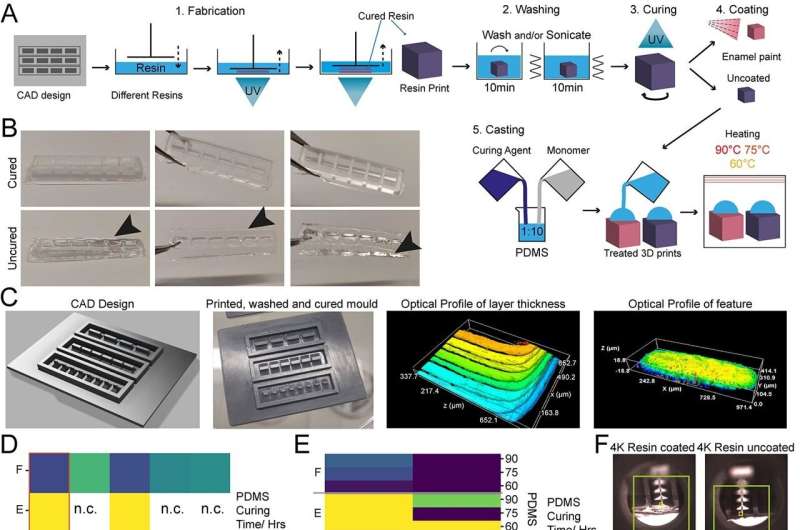This article has been reviewed according to Science X's editorial process and policies. Editors have highlighted the following attributes while ensuring the content's credibility:
fact-checked
peer-reviewed publication
trusted source
proofread
Scientists develop a novel pipeline to create custom cell culture devices

Scientists at the UK Dementia Research Institute at King's at the Institute of Psychiatry, Psychology & Neuroscience have developed a process enabling custom cell culture device creation. This pipeline has been published in PLOS Biology and is available as an open source on GitHub.
Cell culture devices, such as microwells and microfluidic chips, support the physical environments for cells in the laboratory setting. These devices enable scientists to observe how cells grow and interact with each other under different test conditions.
Wet labs currently have to use commercially developed microdevices, which are expensive and don't allow for any customization, narrowing the scope of research that can be undertaken, or they need both the expertise and access to the equipment to produce their own. The latter option offers the possibility of creating bespoke designs, but access to the right equipment, expertise and sometimes cost, poses a significant barrier to entry.
To address these limitations, the Serio Group used their expertise in bioengineering and microfabrication coupled with commercially available low-cost instruments to create a pipeline called SOL3D (Soft-lithography on 3D vat polymerized), which allows to design and make high-resolution customizable devices in a flexible, easy and accessible way.
With this pipeline, any lab can use widely available desktop 3D printers and printing materials (resins) to create a custom "mold" to produce a cell culture device. The pipeline can be adapted for various research needs as it was developed by testing various printers and resins on multiple cell types.
The Serio Group developed custom microdevices in their research into the relationship between nerve length and its function. They recognized the need to create custom microdevices for the cells to grow longer than what was possible with commercial platforms. More than eight research groups worldwide have already adopted this pipeline for their work, even when the paper was still at the preprint stage.
"The SOL3D pipeline not only bridges the gap between biology and physics but also promotes open research and democratizes the use of microdevices. It may bring down the price of each experiment and allow researchers worldwide to be more creative. You can create the right microdevices for your experiment instead of limiting your experiment to what's currently available," says Cathleen Hagemann, postdoctoral researcher and the study's co-first author.
The Serio Group joined UK DRI at King's in 2023, bringing his motor neuron disease (MND) and RNA expertise. He will be opening a microfabrication facility in Maurice Wohl Neuroscience Institute at King's Denmark Hill campus in 2024.
"The new microfabrication facility will promote collaborative research across the university. We will be able to create new and better cell models to answer various research questions and accelerate progress. My group will be providing expertise and expanding beyond our work on motor neuron disease," says Andrea Serio, reader in neural tissue engineering and the study's lead author.
More information: Cathleen Hagemann et al, Low-cost, versatile, and highly reproducible microfabrication pipeline to generate 3D-printed customised cell culture devices with complex designs, PLOS Biology (2024). DOI: 10.1371/journal.pbio.3002503
Journal information: PLoS Biology
Provided by King's College London





















